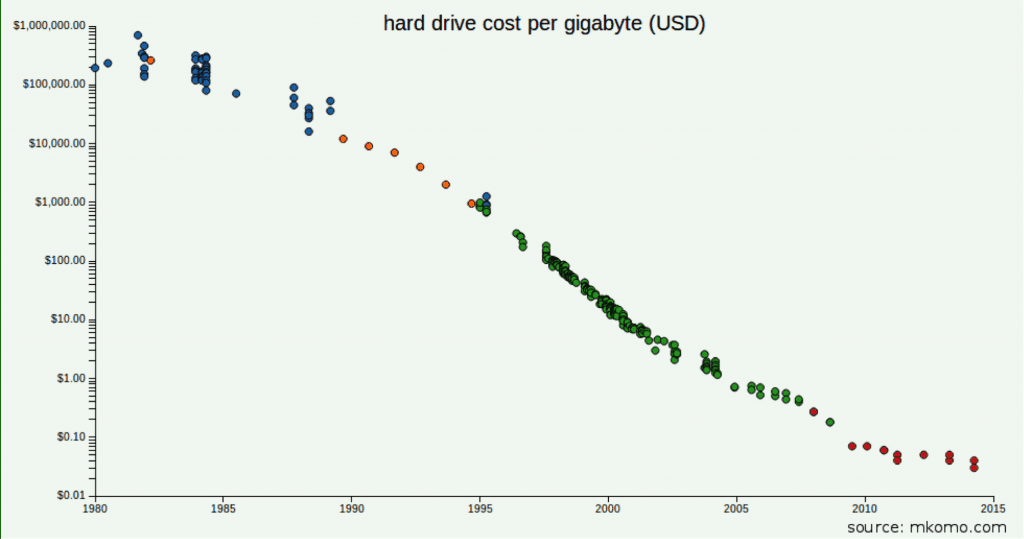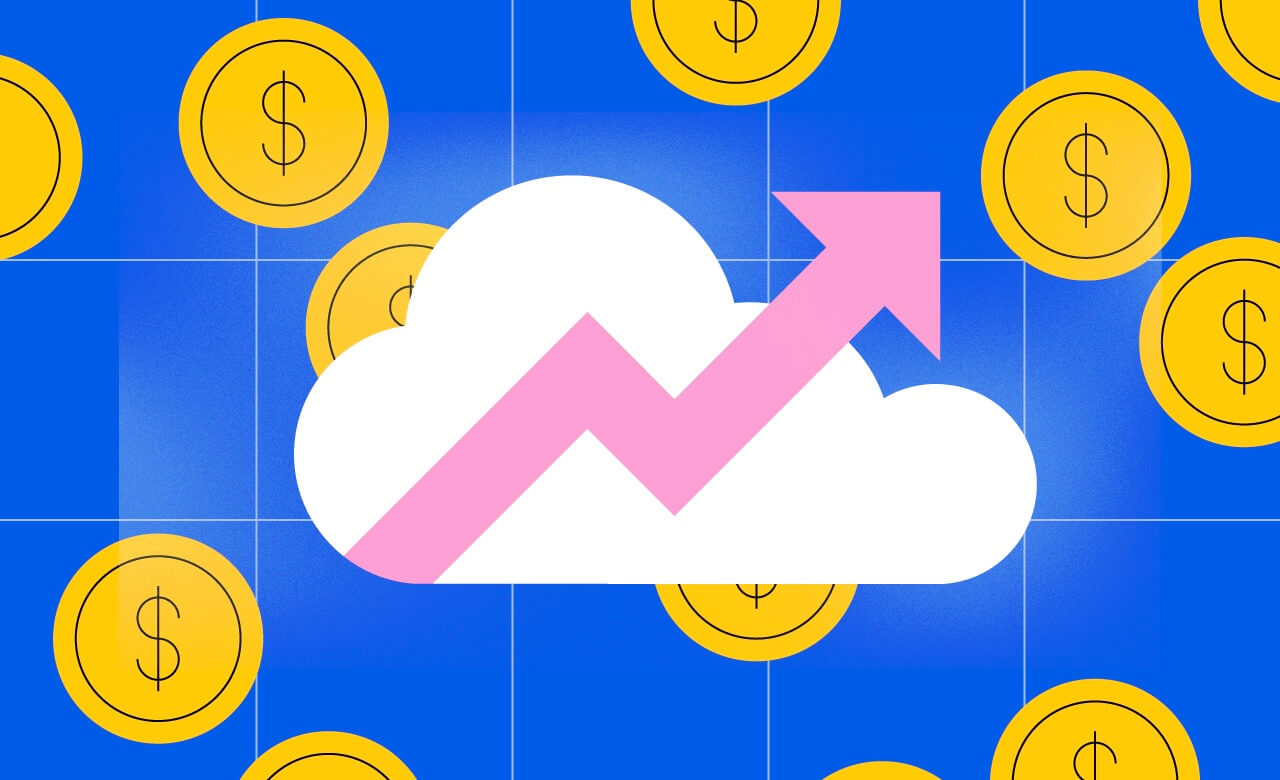Temps de lecture : 4 minutesLa tarification du stockage en nuage fait depuis longtemps l'objet d'une course vers zéro, et les clients pourraient être les gagnants si vous dépensez judicieusement.
Il faut savoir que les services de stockage de base coûtent aujourd'hui environ 0,022 $ par Go/mois chez les principaux fournisseurs comme AWS et Google Cloud. Les options destinées aux particuliers et aux petites entreprises, comme DropBox, offrent une quantité limitée de stockage gratuit et vendent 1 à 2 To pour environ 99 dollars par an, soit moins d'un centime par Go/mois.
Les clients devraient avoir du mal à contester un stockage "presque gratuit" qui vous permet de payer au fur et à mesure et de ne payer que ce que vous utilisez.
Lorsque l'alternative consiste à acheter des baies de stockage d'entreprise et à payer d'avance une capacité fixe à 2 ou 3 dollars par Go, le choix semble clair : pour les clients, la baisse des prix est un avantage net.
D'un autre côté, plusieurs articles ont souligné qu'il peut y avoir des risques potentiels pour la qualité du service et une possibilité d'augmentation future des prix.
Les fournisseurs de services en nuage ont toujours tiré parti de ces préoccupations en proposant des tarifs bloqués si vous optez pour des volumes de stockage plus importants. Voici pourquoi vous devez éviter ce "piège de la majoration" et ce que vous pouvez faire pour obtenir les prix que vous méritez.
Pourquoi vous ne devriez pas payer pour plus que ce que vous utilisez
Le stockage dans le nuage présente un avantage majeur en termes de prix : l'évolutivité qui croît avec vous.
Les entreprises commettent l'erreur d'acheter du stockage en nuage comme des vêtements pour enfants. Au lieu de payer d'avance pour les chaussures surdimensionnées - ou le stockage - qui iront demain, vous pouvez payer pour l'option qui va aujourd'hui. Pourquoi ? Parce que, contrairement aux vêtements, votre stockage peut s'étendre de manière transparente et à la demande.
Comme la courbe des prix du stockage suit une tendance à la baisse depuis des décennies, il n'est pas souhaitable d'acheter une grande quantité d'avance.

Si la courbe des prix d'un produit ressemble à ceci, vous ne devez acheter que la quantité de ce produit dont vous avez besoin aujourd'hui. Acheter deux ou trois ans à l'avance vous coûtera beaucoup plus cher à l'avenir.
Le stockage en nuage présente de nombreux avantages en termes de coûts par rapport au modèle traditionnel de stockage sur site. Nous avons donc été surpris d'apprendre que plusieurs fournisseurs tiers se livrent à des jeux de majoration et de verrouillage des prix avec le stockage en nuage qui vont à l'encontre de la possibilité de consommer le stockage en nuage comme un service public.
En général, les solutions qui relient l'infrastructure sur site au stockage en nuage d'une manière ou d'une autre et qui regroupent le stockage en nuage avec la solution sont celles qui facturent comme une matrice de stockage dans le nuage plutôt que comme un service de stockage.
Les offres groupées peuvent jouer en votre faveur, mais peuvent aussi jouer contre vous si les prix baissent. Et Amazon a réduit les prix des dizaines de fois pour ses différents services depuis le lancement d'AWS en 2006. Le service de stockage S3, qui coûtait au départ 0,15 dollar par Go et par mois, est désormais proposé à 0,023 dollar, soit une baisse de près de 85 %.
Quels sont les signaux d'alarme à surveiller en matière de tarification du stockage en nuage ?
Sur la base de conversations avec plusieurs clients, nous avons identifié plusieurs éléments dont il faut se méfier lorsqu'on achète du stockage en nuage par l'intermédiaire d'un tiers :
- Prix bloqués. Certains fournisseurs verrouillent les prix pour la durée du contrat. Cela signifie que vous ne pouvez pas faire baisser le coût du stockage en nuage lorsque les prix baissent.
- Capacité initiale fixe. Un client nous a dit qu'il avait dû acheter ce qui équivalait à une "étagère de stockage en nuage", c'est-à-dire une quantité fixe de stockage dans le cadre d'un contrat de trois ans. Il payait pour un stockage en nuage qu'il n'utilisait pas encore et dont le prix était bloqué, ce qui revenait en fait à acheter du stockage sur site.
- Facturation de la capacité logique plutôt que de l'utilisation réelle. La plupart des solutions de filtrage en nuage dédupliquent et compressent les données pour économiser de l'espace dans le nuage, et devraient donc répercuter ces économies sur le client. Si ce n'est pas le cas, vous paierez le prix fort pour vos 20 To, même si la capacité réelle du cloud bucket n'est que de 3 To après déduplication et compression.
- Prix majorés. Pour couronner le tout, un autre client nous a dit avoir calculé que le stockage en nuage lui était facturé à près de 100 %. Il payait également pour une capacité logique plutôt que déduite, ce qui portait la majoration à près de 400 %.
- Aucun choix de fournisseur de cloud. Si le stockage en nuage est associé à une autre solution, le fournisseur choisit probablement le fournisseur de nuage qui lui convient le mieux. Vous devriez pouvoir choisir celui qui vous convient le mieux.
- Propriété des données. Vous devriez vous sentir en sécurité si vos données sont stockées dans votre compte chez AWS, Google, Microsoft ou un autre grand fournisseur. Mais qu'en est-il si quelqu'un d'autre possède et gère le compte ? Si un petit fournisseur de solutions se trouve entre vous et le cloud, vous risquez de perdre vos données si le fournisseur fait faillite (rappelez-vous Nirvanix, lorsque les clients ont dû se démener pour sortir leurs données).
Les prix du stockage dans le nuage baissent de moitié tous les 18 mois environ. Accepter un contrat à prix fixe n'a donc guère de sens. Vos pairs et vos concurrents qui s'inscrivent plus tard obtiendront de meilleurs prix que vous.
C'est l'équivalent moral de la tarification de la télévision par câble. Vous acceptez un contrat d'un ou deux ans pour bénéficier d'une promotion, puis votre fournisseur vous propose une meilleure offre 12 mois plus tard - mais elle n'est disponible que pour les nouveaux clients.
Vous ne devriez pas avoir à vérifier constamment le prix du stockage en nuage pour vous assurer que vous bénéficiez de la meilleure offre. Vous devriez simplement récolter les économies réalisées lorsque les prix baissent dans le secteur.
Shift the balance of power in the fight against ransomware.
Points à retenir sur la tarification du stockage en nuage
En fin de compte, vous êtes généralement mieux servi lorsque vous profitez de l'échelonnement flexible qu'offre le stockage en nuage.
Acheter la marge de manœuvre avant d'en avoir besoin n'est ni nécessaire ni judicieux dans le cas du stockage en nuage. Profitez plutôt de la baisse des prix et affectez les économies réalisées à des technologies qui amélioreront l'expérience de votre entreprise en matière de cloud.
À cet égard, nous pensons qu'il est clair que vous devez acheter le stockage en nuage séparément de toute technologie sur site qui vous connecte au nuage. Vous vous méfieriez si votre fournisseur d'accès à Internet vous proposait de regrouper AWS S3, Azure BLOB ou Google Cloud Storage avec son service Internet ; vous devriez être tout aussi sceptique à l'égard des fournisseurs d'infrastructure qui font de même.
Un système de fichiers en nuage hybride intelligent donne l'impression de faire partie de votre centre de données, mais nous pensons que vous devez choisir votre fournisseur de nuage et profiter pleinement de l'économie du nuage lorsque les prix baissent. Nous prenons entièrement en charge la plupart des fournisseurs publics et de cloud computing, afin que vous puissiez choisir celui qui vous convient le mieux.



















